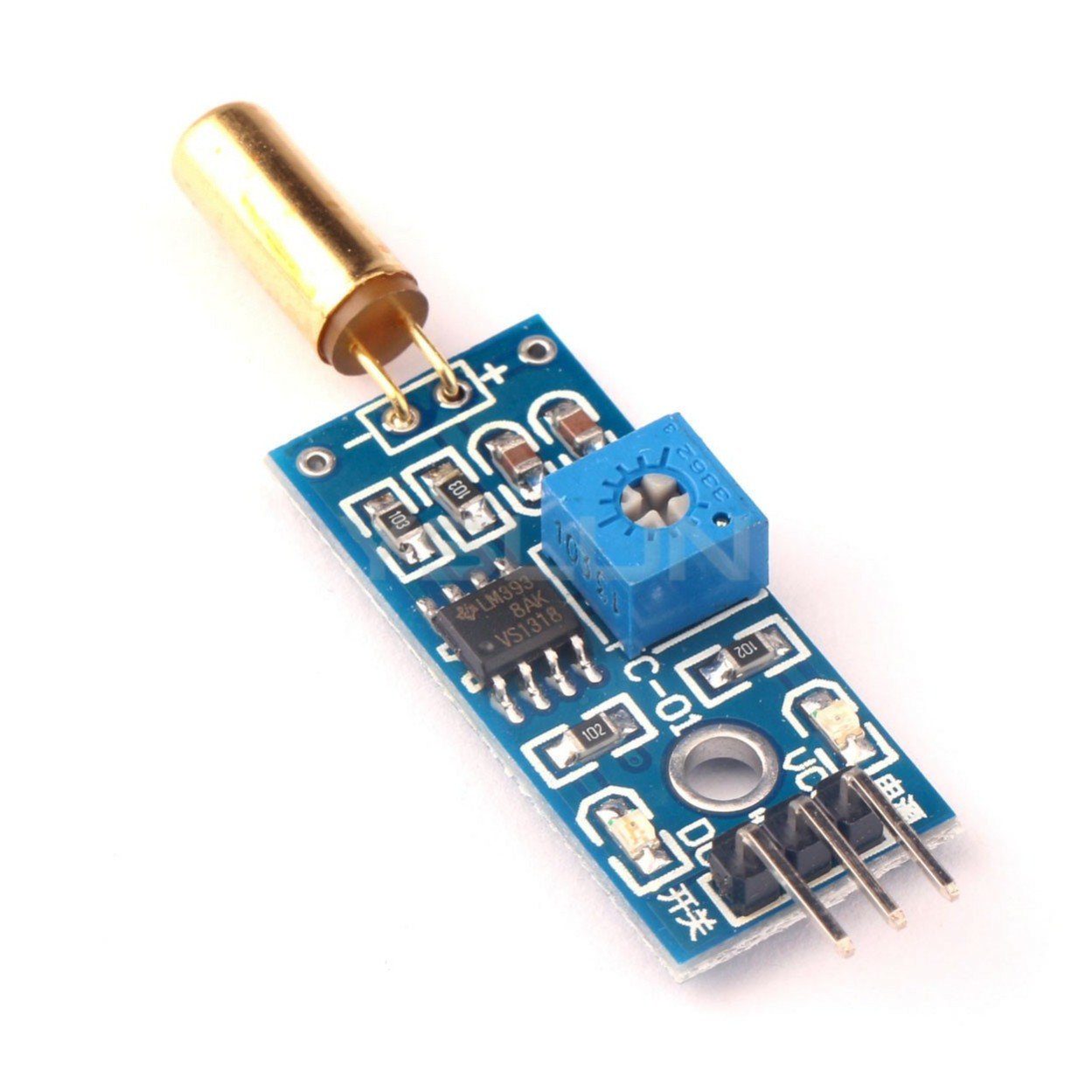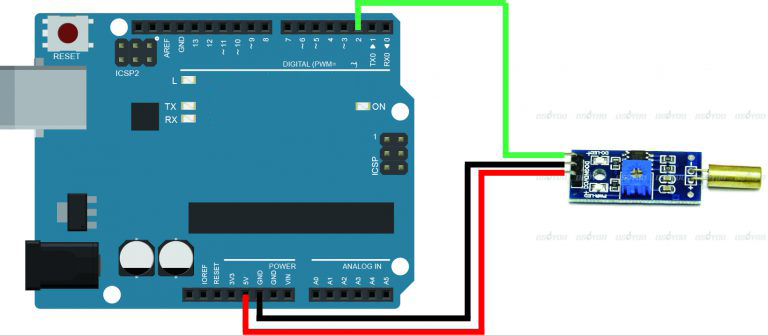








Tilt Sensor Vibration Alarm Vibration Switch Module for Arduino
This tilt sensor module consists of a tilt sensor and an onboard potentiometer. Just like vibration sensors, tilt sensors trigger when a change in orientation/displacement occurs. For this particular module, it outputs LOW when the tilt sensor is activated and HIGH when it is in default.
₹ 49 ₹99
99



| Made In : | India |
Add FAQ
A Tilt Sensor Module is a device used to detect the tilt or inclination of an object or surface relative to gravity. It is often used in applications where it is important to detect the orientation or angle of an object, such as in robotics, gaming, automotive systems, and safety applications.
Types of Tilt Sensors:
-
Mechanical Tilt Sensors:
- These sensors use a ball bearing or a pendulum inside a sealed enclosure. When the sensor tilts, the ball bearing or pendulum moves and makes contact with a switch, activating it.
- These sensors typically have two states: ON when tilted past a certain angle and OFF when upright.
-
Capacitive Tilt Sensors:
- These sensors use the change in capacitance to detect the angle of inclination. The capacitance varies as the orientation of the sensor changes.
-
Membrane Tilt Sensors:
- These sensors contain a flexible membrane that reacts to tilt by changing its resistance. The resistance changes as the sensor is tilted, and this change is measured to determine the angle.
-
Solid-State Tilt Sensors (often used in modern modules):
- These sensors utilize MEMS (Microelectromechanical Systems) technology, which relies on small mechanical structures integrated into a chip. When the sensor tilts, the microstructure moves and changes the output signal, which is then read by the connected system (like an Arduino or microcontroller).
Key Features of a Tilt Sensor Module:
-
Voltage Rating: Tilt sensors are typically powered by low-voltage circuits, often in the range of 3.3V or 5V, making them compatible with microcontrollers such as Arduino and Raspberry Pi.
-
Output Type:
- Digital Output: Many tilt sensors have a simple ON/OFF digital output. The sensor either activates or deactivates a switch when the tilt angle exceeds a certain threshold.
- Analog Output: Some tilt sensors provide an analog output that varies with the degree of tilt, providing more precise information about the angle of inclination.
-
Response Time: These sensors can be quick in responding to tilt changes, and the response time can range from milliseconds to several seconds, depending on the design.
-
Sensitivity: Tilt sensors can have different sensitivities, meaning they can detect very small or large tilts. Some sensors allow you to adjust this sensitivity.
-
Size: Tilt sensor modules vary in size, but many are small enough to fit into compact devices and projects.
-
Operating Angle: Tilt sensors typically have a predefined tilt angle threshold, beyond which the switch will trigger. This angle can vary from a few degrees (e.g., 15° to 30°) to larger angles depending on the sensor.
Common Applications of Tilt Sensors:
-
Robotics:
- Used to detect the orientation of a robot, helping it maintain balance or detect when it has tipped over.
- Provides feedback for inverted robots to perform recovery maneuvers.
-
Mobile Devices:
- Tilt sensors are used in smartphones and tablets for screen orientation, allowing the device to detect whether it should display in portrait or landscape mode.
- Often used in gaming applications for controlling devices via tilt motion.
-
Safety Devices:
- Tilt sensors are commonly found in safety systems, such as tilt alarms in vehicles or machinery. If an object or vehicle tilts beyond a safe angle, it can trigger an alert to warn the operator or shutdown the device.
-
Level Measurement:
- Used in devices that require precise leveling or calibration, such as construction tools or precision measuring instruments.
-
Automotive:
- Used in car alarm systems to detect if the car is tilted or lifted, for example, when the car is being towed or stolen.
- Helps in stability control systems to monitor the vehicle's tilt during maneuvers.
-
Toys and Games:
- Tilt sensors are used in gaming devices and toys, such as board games that detect the angle or position of the game pieces.
-
Home Automation:
- Tilt sensors are used in smart furniture or appliances to monitor if a device has been tilted or moved, for example, detecting if a refrigerator door is open or if a washing machine has become unbalanced.
Working with a Tilt Sensor Module (e.g., Digital Tilt Sensor):
When using a digital tilt sensor module, it typically has the following components:
- VCC pin: To power the module (usually 5V or 3.3V depending on the module).
- GND pin: Ground connection.
- DO (Digital Output): A pin that outputs HIGH or LOW depending on the tilt.
- AO (Analog Output): An optional pin (for analog sensors) that outputs a value related to the tilt degree.
Example: Connecting a Tilt Sensor to an Arduino
-
Hardware Connections:
- VCC: Connect to 5V or 3.3V on the Arduino.
- GND: Connect to GND on the Arduino.
- DO (Digital Output): Connect to a digital pin (e.g., pin 2).
-
Arduino Code:
// Define the pin connected to the Tilt sensor
const int tiltPin = 2; // Digital input pin where the tilt sensor is connected
int tiltState = 0; // Variable to store the current state of the sensor
void setup() {
// Start serial communication for debugging
Serial.begin(9600);
// Set the tiltPin as an input
pinMode(tiltPin, INPUT);
}
void loop() {
// Read the state of the tilt sensor (HIGH or LOW)
tiltState = digitalRead(tiltPin);
// Print the result to the Serial Monitor
if (tiltState == HIGH) {
Serial.println("Tilted!");
} else {
Serial.println("Upright!");
}
// Wait for a short time before checking again
delay(500);
}
Explanation of the Code:
- The
tiltPinis set as an input to read the state of the tilt sensor. - In the
loop()function, the Arduino reads the value from the tilt sensor usingdigitalRead(). If the sensor detects a tilt, it will output HIGH; otherwise, it will output LOW. - The result is printed to the Serial Monitor, indicating whether the object is tilted or upright.
Tilt Sensor Module with Analog Output Example:
If you are using a tilt sensor with an analog output, you would read the analog value to determine the degree of tilt. Here's an example:
// Define the analog pin connected to the Tilt sensor
const int tiltPin = A0; // Analog input pin
void setup() {
// Start serial communication for debugging
Serial.begin(9600);
}
void loop() {
// Read the analog value from the tilt sensor
int tiltValue = analogRead(tiltPin);
// Print the analog value to the Serial Monitor
Serial.println(tiltValue);
// Wait for a short time before reading again
delay(500);
}
Conclusion:
A Tilt Sensor Module is a simple and useful device for detecting the orientation or tilt of an object, with applications in robotics, safety systems, and gaming. It can come in different forms, such as digital (ON/OFF) or analog (providing a continuous value based on the tilt degree). These sensors are easy to integrate with microcontrollers like Arduino and Raspberry Pi for various projects, allowing you to monitor or trigger actions based on the tilt or orientation of objects.

0 Reviews For this Product












.jpg&width=225&quality=80)
